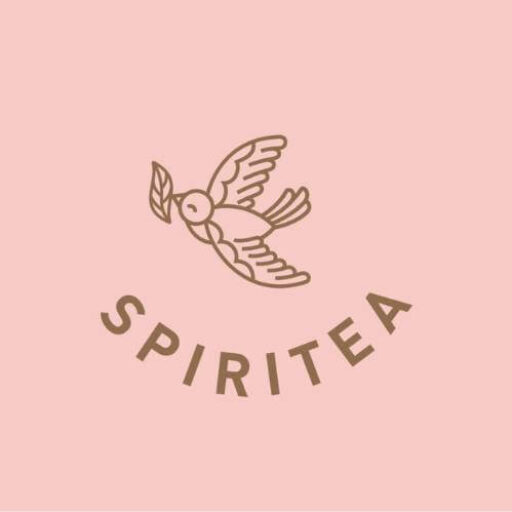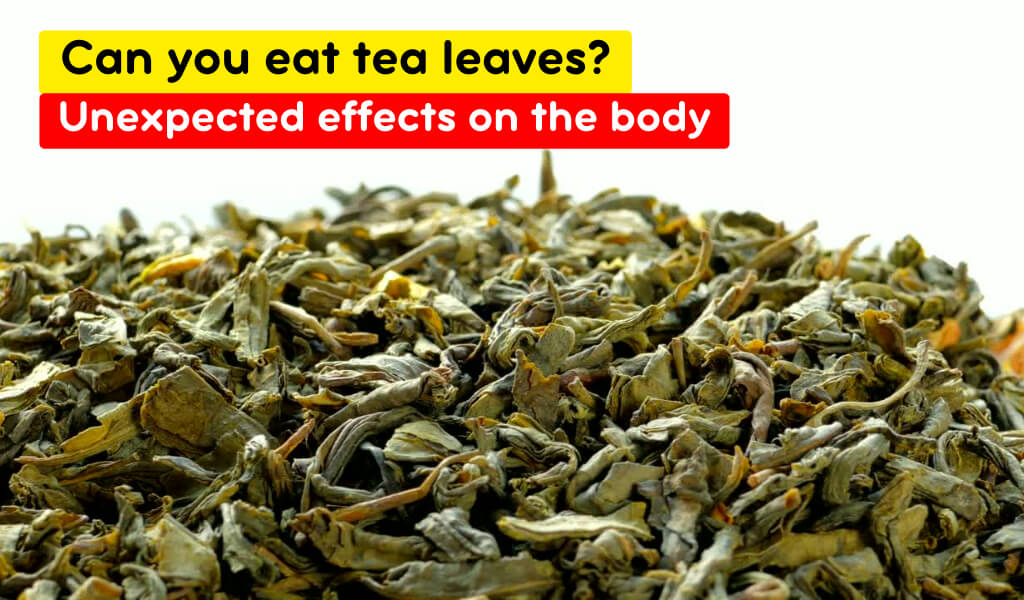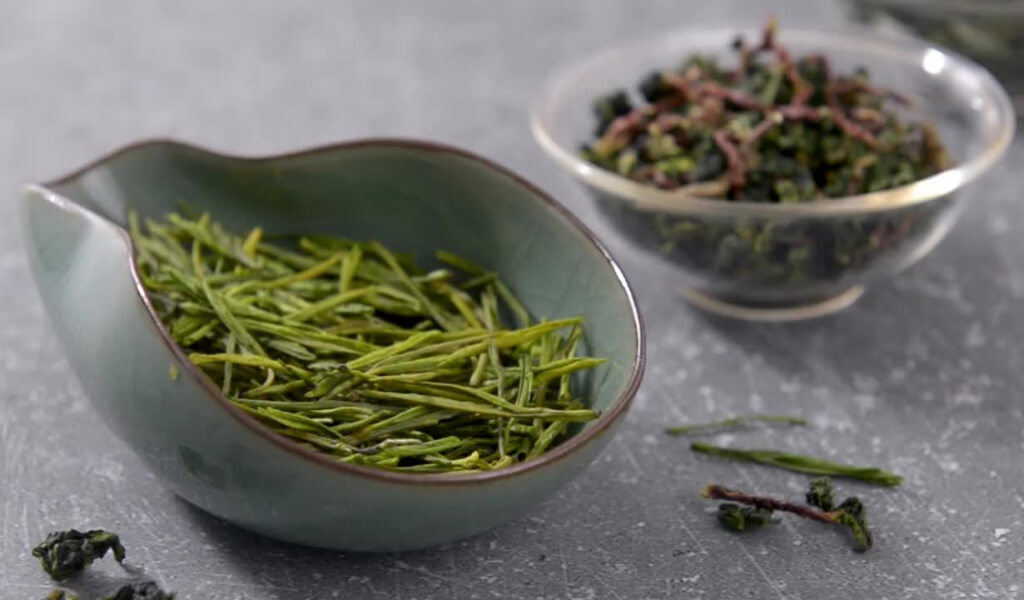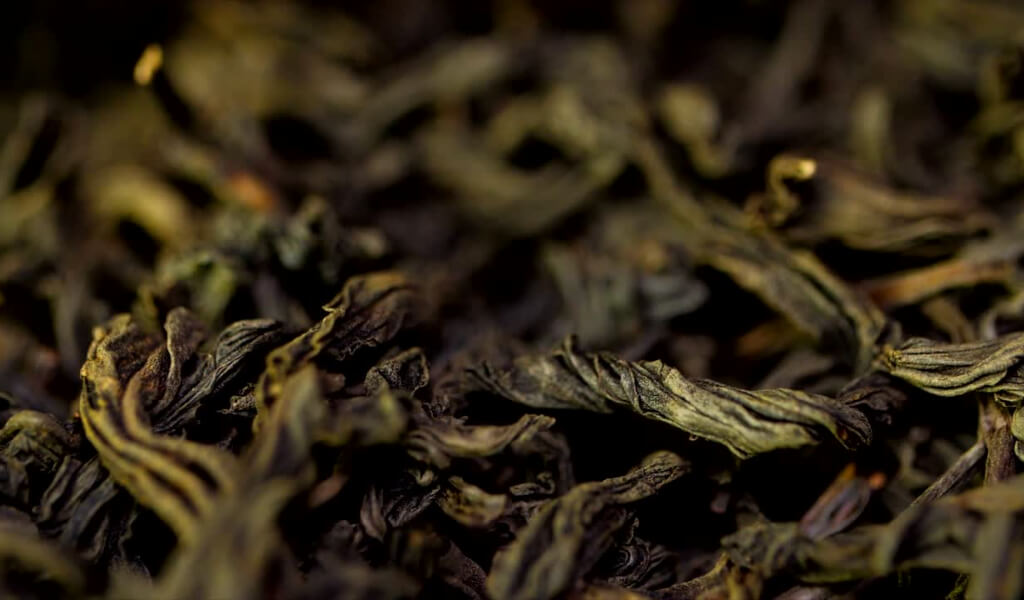Can you eat tea leaves? The answer is yes, you can! Consuming loose tea leaves isn’t just harmless; it’s beneficial in several ways, including providing a good dose of Vitamin A. Be mindful that tea leaves often contain more caffeine than coffee beans per volume. It’s always wise to check with your doctor for dietary concerns.
So, if you’ve unintentionally gulped down some loose tea leaves while savoring your last sip, don’t fret – it’s perfectly okay.
But this brings us to another intriguing question: What exactly is in these tea leaves? Is it okay to drink tea leaves? And could there be benefits to eating them dry? Let’s dive in to explore further.
Will Drinking Tea Leaves Hurt You?
So, are tea leaves edible? The short answer is no, and drinking tea leaves won’t hurt you. But let’s explore this in more detail.
Spooning up a heap of loose tea leaves isn’t exactly appetizing, even if it’s a delicious blend with candied fruit or ginger. However, doing so doesn’t pose any health risk to an average person. It could be beneficial, as all the benefits of tea are present in the whole leaf.
You’re unlikely to consume a substantial volume of tea leaves at once, especially if you brewed your tea without an infuser and just left the leaves in the bottom of your cup. While this won’t harm you, it might not be the most pleasant experience. Think about it: you could technically eat dried ramen, but would you want to?
Using dried tea in cooking, particularly baking is becoming more popular. Why not experiment a little? Add Earl Gray to your cake mix or jasmine tea to your rice for a beautifully flavored meal. In these cases, you’re using tea much like any other herb. While the tea flavor will be quite pronounced, you wouldn’t overpower your dish with cinnamon or sage either. All herbs, spices, and teas should be used in moderation.
One key point to remember when using loose-leaf tea in cooking is the caffeine content. Just as you would moderate your coffee or energy drink intake, be mindful of the caffeine levels in the tea leaves, you consume.
Can You Eat Tea Leaves? Interesting facts
I can confirm, once again, that you can eat tea leaves. Now, let’s dive into the details.
Most teas, except for a few herbal and fruit varieties, come from the Camellia sinensis plant. These leaves are not only safe but also packed with nutrients. Yet, consuming them directly from the plant may not offer the best taste.
You can gain certain health benefits from eating tea leaves you wouldn’t necessarily get from drinking brewed tea. For example, Vitamin A, which is present in the leaves but not water-soluble, would be more accessible through direct consumption.
The practice of eating tea leaves is familiar. It might even predate the beverage itself. The Burmese dish Laphet Thoke, a salad made from pickled tea leaves, represents 20% of all tea harvested in Myanmar!
Matcha, a powdered green tea leaf, is widely used in East Asian cuisine, particularly in Japan. It’s found in various dishes like milkshakes, tempura batter, ice cream, and even Kit Kats. Tea leaves can be eaten raw or steeped, but steeping them is recommended for easier digestion.
Remember that certain beneficial compounds in tea are only released in hot water. So, eating tea leaves may benefit you differently than drinking brewed tea.
It’s also important to remember that about 80% of the caffeine content in tea is released into your brew, so eating tea leaves will give you a smaller caffeine boost. And let’s remember the taste – it’s a lot to handle alone!
Read More:
- Can You Reuse Tea Bags? Here is My detailed guide and tips
- How many tea bags for a gallon of tea? Sweet, Iced and Sun tea
- Does Tea Go Bad? Here Are The Detailed Guide & Tips
- Can you put cream in tea? The Ultimate Instructions For Newbies
- What is the best Tea to drink? Your Ultimate Guide
Is It Okay To Eat Fresh Tea Leaves?
Yes, it is okay to eat fresh tea leaves. Fresh tea leaves from the Camellia Sinensis plant are safe and packed with beneficial nutrients, similar to many leafy green vegetables. These nutrients include Vitamin A and other antioxidants, which provide several health benefits that can be obtained more readily by eating the leaves rather than steeping them in hot water.
Freshly picked organic tea leaves contain 13 times more antioxidants than tea from the cup. More and more Westerners are consuming fresh green tea leaves and using them in smoothies and other nutrient-dense beverages. In some Asian countries, this is nothing new.
Tea and Coffee Caffeine Content
Tea leaves contain a higher caffeine content of 3.5%, while coffee beans have 1.5%. So, in essence, tea has more caffeine than coffee.
However, if you’re more concerned about the caffeine punch in your morning beverage, coffee will likely provide a stronger jolt of alertness. This occurs because brewing coffee extracts more caffeine from the beans.
Moreover, how we consume these beverages makes a significant difference: when you drink coffee, you’re essentially consuming the concentrated essence of the bean, while with tea, you’re merely infusing water with the tea leaves.
In other words, there’s more caffeine in tea leaves than coffee beans, but coffee often delivers a higher caffeine content when it comes to your morning cuppa. It’s a fascinating contrast that adds another layer to our appreciation of these beloved beverages.
Freshly Picked Green Tea Leaves With Nutritional Benefits
Rich in Essential Nutrients and Minerals
Eating freshly picked green tea leaves can provide a range of essential nutrients and minerals such as Selenium, Magnesium, and Calcium. Unlike when you brew tea, consuming the leaves directly ensures you absorb all these nutrients, many of which are not water-soluble.
High Antioxidant Content
One of the standout benefits of green tea leaves is their high antioxidant content. These antioxidants are more concentrated in the leaves than in the brewed tea, providing potential health benefits like combating oxidative stress.
More Nutrients Than Drinking Tea
Consuming green tea leaves provides higher nutrient intake compared to drinking brewed tea alone. Brewing extracts water-soluble nutrients, leaving behind valuable components like Vitamin E, carotenes, proteins, and specific minerals, which are better absorbed through ingestion.
Source of Both Water-Soluble and Fat-Soluble Nutrients
Green tea leaves contain both water-soluble and fat-soluble nutrients. When you brew tea, the water-soluble nutrients infuse into the water. However, the fat-soluble nutrients (not dissolvable in water), like Vitamin E and carotenes, chlorophyll, proteins, and some minerals, stay in the leaves.
Delightful Taste Addition to Meals
Last, eating green tea leaves can add a mild yet interesting twist to various dishes. Already steeped green tea leaves are so mellow that they’ll blend seamlessly with other ingredients, subtly enhancing the taste while adding a vibrant color accent.
How Can You Get the Benefits From Your Tea?
The Art of Infusion
The key to unlocking the benefits of any tea, be it green, white, or black, lies in the infusion process. Steeping tea in hot water extracts important elements, flavor, and caffeine. Infusion is critical to accessing the beneficial components of tea.
On Reusing Tea Leaves
While tea leaves can be reused a few times, each subsequent cup becomes less rich. Besides Pu’er tea, most antioxidants and caffeine are depleted after the first steeping. Reusing tea leaves won’t yield the same benefits as the initial brew.
Eating Tea Leaves: A Misconception
Contrary to some beliefs, eating used, moist tea leaves is pointless. The beneficial components we treasure in tea are water-soluble and best accessed through brewing. Eating the leaves directly doesn’t provide the same benefits as drinking the infused tea.
The Universal Truth About Tea Benefits
Regardless of the type – Green, White, Black, Pu’er, or Oolong – all teas from the Camellia sinensis plant share this fact. While processing techniques and leaf maturity vary, the best way to extract benefits remains consistent: through infusion, not by eating the leaves.
Tea Leaves Side Effects To Eat
Addiction Potentiality
When you consume tea leaves, your body absorbs and releases caffeine into your bloodstream. This can lead to a boost in mood and energy, but regular consumption can result in tolerance, needing more to achieve the same effect. Tea leaf eating could lead to caffeine addiction.
Tooth Decay from Tea Leaves
Tea leaves’ hard, abrasive texture, especially when dry, can become stuck in your teeth, leading to discomfort and potential tooth decay. Additionally, tea leaves are full of bacteria that can get trapped between your teeth and gums, leading to bad breath. Chewing on tea leaves can lead to tooth decay and bad breath.
Illness from Unbrewed Tea Leaves
Eating raw tea leaves can make you sick due to bacteria, and the caffeine in them can also be harmful if absorbed too rapidly, like when you chew them instead of brewing.
Excessive Fluoride Intake
Tea leaves contain fluoride, which is beneficial for teeth in small amounts. However, consuming tea leaves in large quantities can result in a toxic level of fluoride. Eating too many tea leaves could result in excessive fluoride intake.
Tannins Presence in Tea Leaves
Tannins in tea leaves can cause headaches and nausea. These compounds can also lead to stomach discomfort and diarrhea when consumed in excess. Consuming too many tea leaves can lead to headaches, nausea, and digestive discomfort due to tannins.
The Unpleasant Taste
The taste of tea leaves can be bitter or sour, and their texture might be unpleasant. They may also leave a tingling sensation in your mouth for hours after consumption. Tea leaves may have a bitter or sour taste and an unpleasant texture when eaten.
Recommended Types of Tea to Eat
If you’ve made it this far into this article, it should be clear that not all teas are created equal, especially when consuming them directly. However, certain types of tea are more suitable for direct consumption. Here are some types I’ve found to be the best:
White Tea
White tea is an excellent option to consider. Similar to green tea, it’s unoxidized and crafted from young shoots, packing a punch of caffeine and nutrients. Whether you prefer it fresh or dried, white tea offers a complete tea experience.
Dried Green Tea Leaves
Dried green tea is another good option, albeit slightly inferior to its fresh counterpart. The leaves are heat-treated to stop oxidation and then dried. Although it’s edible, I can assure you from personal experience that fresh leaves are always better.
Black Tea
Being dried and oxidized tea leaves, black tea offers a unique, stronger, and more bitter flavor. I’ve tried munching on loose-leaf black tea a few times, and while it’s a matter of personal preference, I lean toward fresh leaves.
Oolong Tea
Oolong tea can be seen as the midpoint between green and black tea, with varying oxidation levels. The taste and texture of eating oolong tea depend on its oxidation level and can range from sweet and fruity to earthy and slightly nutty. Regardless, it offers a distinctive experience falling between green and black tea.
Fresh Green Tea Leaves
If you’ll nibble on tea, fresh-picked green tea leaves are your best bet. Not only will you receive the most benefits, but it’s also less likely to upset your stomach than other tea types.
Like any other fresh herb, you can freeze the leaves to keep them fresh longer. When I first tried fresh green tea leaves, I remember the taste was surprisingly pleasant and refreshing!
Can eating tea bags kill you?
Technically, you can eat the tea from tea bags, but it’s not a culinary delight and may cause stomachache. Eating tea from a bag isn’t typically recommended; for clarity, don’t consume the actual bag material.
Not all tea bags are filled with high-quality tea leaves. Some can contain less desirable elements, such as factory dust or debris. The quality of tea can greatly vary depending on the manufacturing process and source.
Higher-quality, more expensive tea bags are less likely to contain unwelcome ingredients. The content of these bags is far safer and more pleasant to consume compared to lower-quality tea bags that you might find in the supermarket. The better the quality of the bagged tea, the less likely you’ll encounter problems if you decide to consume it.
Tasty Things to Come With Tea Leaves
So, what do you eat with tea? With its vast array of flavors, tea can be paired with various foods. Whether you’re hosting a high tea or simply enjoying a relaxing afternoon break, here are some delicious options to consider when deciding on what to eat with tea:
- Pastries: From scones and biscuits to strudels and croissants, pastries are a delightful companion to a cup of tea. The buttery, flaky textures complement the tea’s smoothness and can create a harmony of flavors.
- Sandwiches: Cucumber sandwiches or other finger sandwiches must be noticed if you’re aiming for a classic English tea party. They provide a light, savory balance to the typically sweet fare.
- Cheese and Crackers: A fine cheese can pair wonderfully with certain teas. The astringency of a strong black tea can perfectly offset the creamy richness of the cheese.
- Chocolate: Whether rich, dark chocolate or smooth milk chocolate, pairing it with a robust tea like Earl Grey or a smoky Lapsang Souchong can create an indulgent treat.
- Fruits and Nuts: Fresh fruits and nuts can add a healthy, refreshing touch to your tea time. They offer a natural sweetness and crunch to enhance the tea-drinking experience.
Recalling a visit to a Kyoto tea house in autumn 2023, I enjoyed fresh matcha tea served with sweet mochi and sakura rice crackers on a crisp day.
The combination of the earthy matcha with the sweet and salty accompaniments was unforgettable, bringing a depth of flavor that truly elevated the tea-drinking experience.
Thanks from Spiriteadrinks.com
FAQs
Is it safe to drink tea leaves from tea bags?
While it is technically safe to eat the tea leaves from tea bags, it’s not recommended due to the low quality and potential dust or debris in the bag. Higher-quality, loose-leaf teas are a safer and tastier choice for eating.
Is it safe to chew on green tea leaves?
Yes, it’s safe to chew on green tea leaves, but it’s important to remember that they contain caffeine, and excessive consumption could lead to caffeine overload. Chewing green tea leaves also risks tooth decay due to the dried leaves’ hard and abrasive nature.
Why do people eat tea leaves?
People consume tea leaves for their abundant antioxidants and nutrients, as well as the distinctive flavor they offer compared to brewed tea. Proper brewing is essential to unlock these health benefits.
Should I crush tea leaves?
No, it’s generally not advisable to crush tea leaves. Crushing can release tannins and lead to a bitter, overly strong taste in your tea. Keeping the leaves whole allows for a more controlled infusion process.
What do tea leaves taste like?
The taste of tea leaves can vary greatly depending on their type and preparation. Green tea leaves often have a grassy, slightly bitter flavor, while black tea leaves can taste robust. Eating tea leaves typically provides a more intense flavor than drinking the infusion.
Do tea leaves taste better than tea bags?
Yes, loose tea leaves usually taste better than tea from tea bags. Loose tea is typically higher quality and fresher, resulting in a more complex and enjoyable flavor profile.
Is it OK to pour tea leaves down the sink?
While it may seem harmless, consistently pouring tea leaves down the sink can lead to blockages over time. It’s better to compost or dispose of tea leaves in the trash.
How many times can you reuse tea?
Most tea leaves can be steeped 2-3 times before they lose flavor. However, the number of times you can reuse tea leaves depends on the type of tea. For instance, Pu’er tea can be steeped up to 10 times without significant loss of flavor.
Can you get caffeine from eating tea leaves?
Eating tea leaves can deliver caffeine into your system, just like drinking brewed tea. The caffeine content varies depending on the type of tea leaf, with younger leaves generally containing more caffeine.
Can I eat tea leaves raw?
Yes, tea leaves can be eaten raw, but they taste bitter due to their natural tannins. Brewing tea leaves helps to release their flavor and health benefits in a more palatable way.
Are all tea leaves edible?
Most tea leaves, especially those from the Camellia sinensis plant, are edible. This includes green, black, white, and oolong tea leaves. But is it ok to drink the herbs in tea? Unfortunately, not all herbal “teas” come from edible plants, so always ensure you know what you consume.
Can you drink loose tea leaves for weight loss?
Eating tea leaves can provide a small amount of catechins and caffeine that are thought to support weight loss. However, consuming these compounds through brewed tea is usually more beneficial as part of a balanced diet and exercise routine.
I’m Shanna, creator of Spiritea Drinks. I’m all about teaching people to grow their own food, tea, cook what they harvest, and eat with the seasons.





